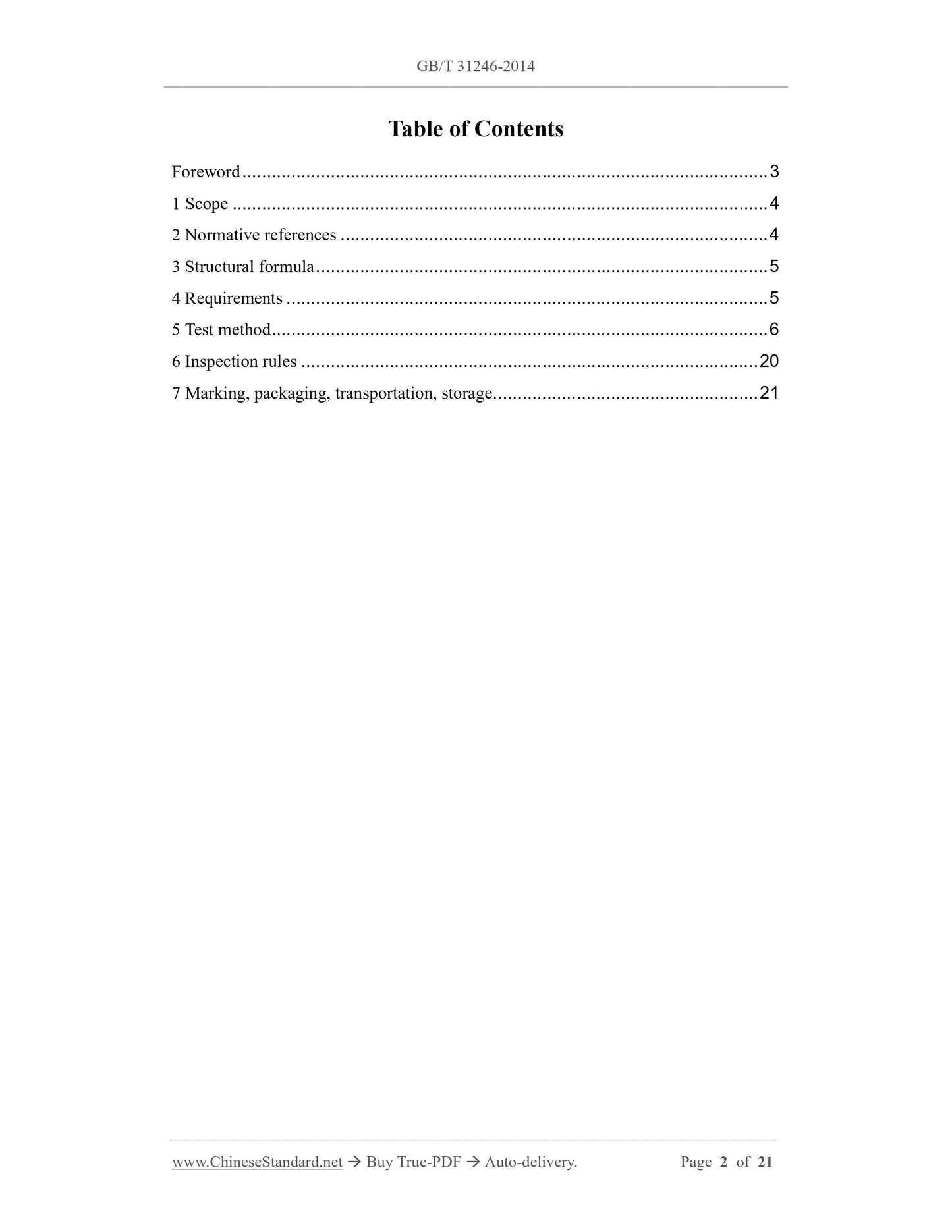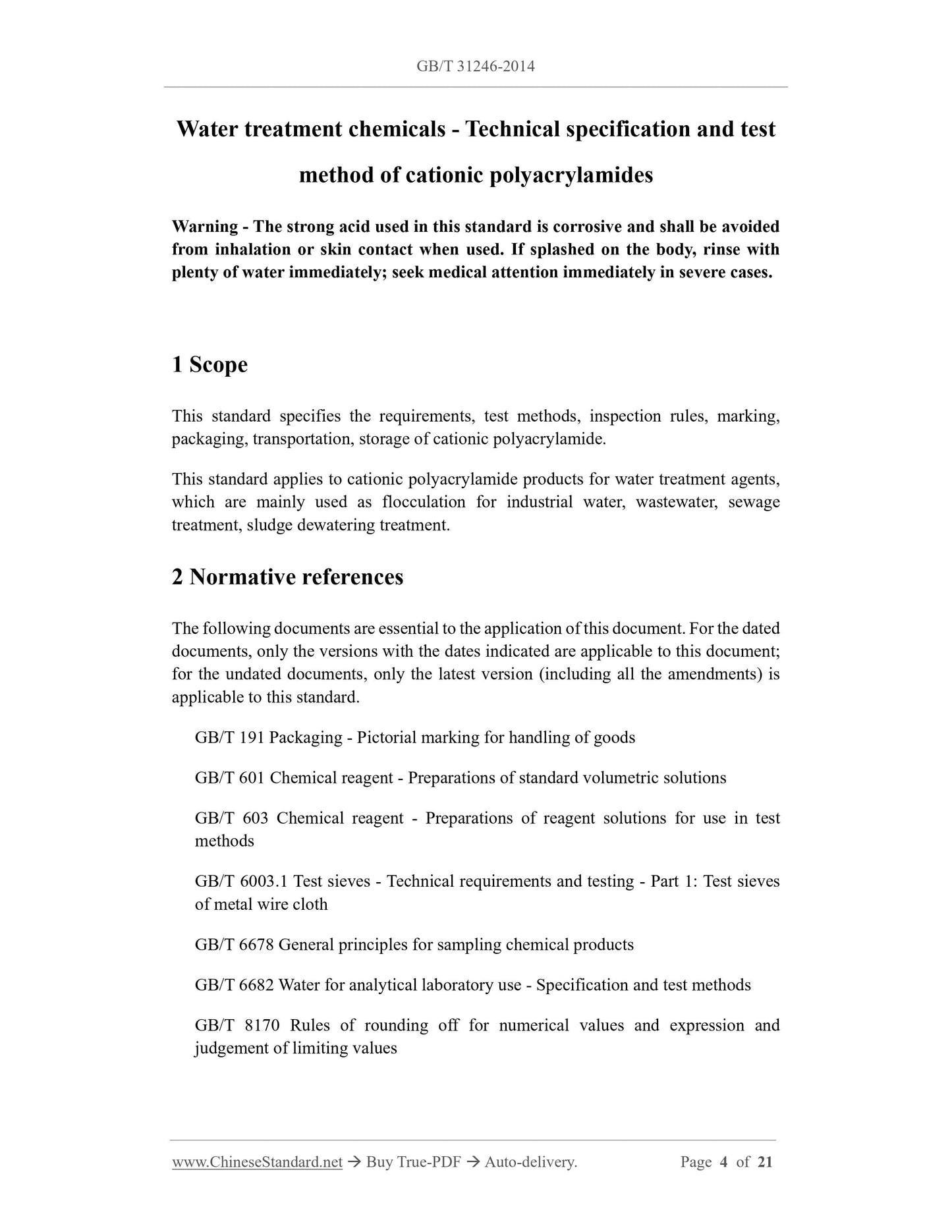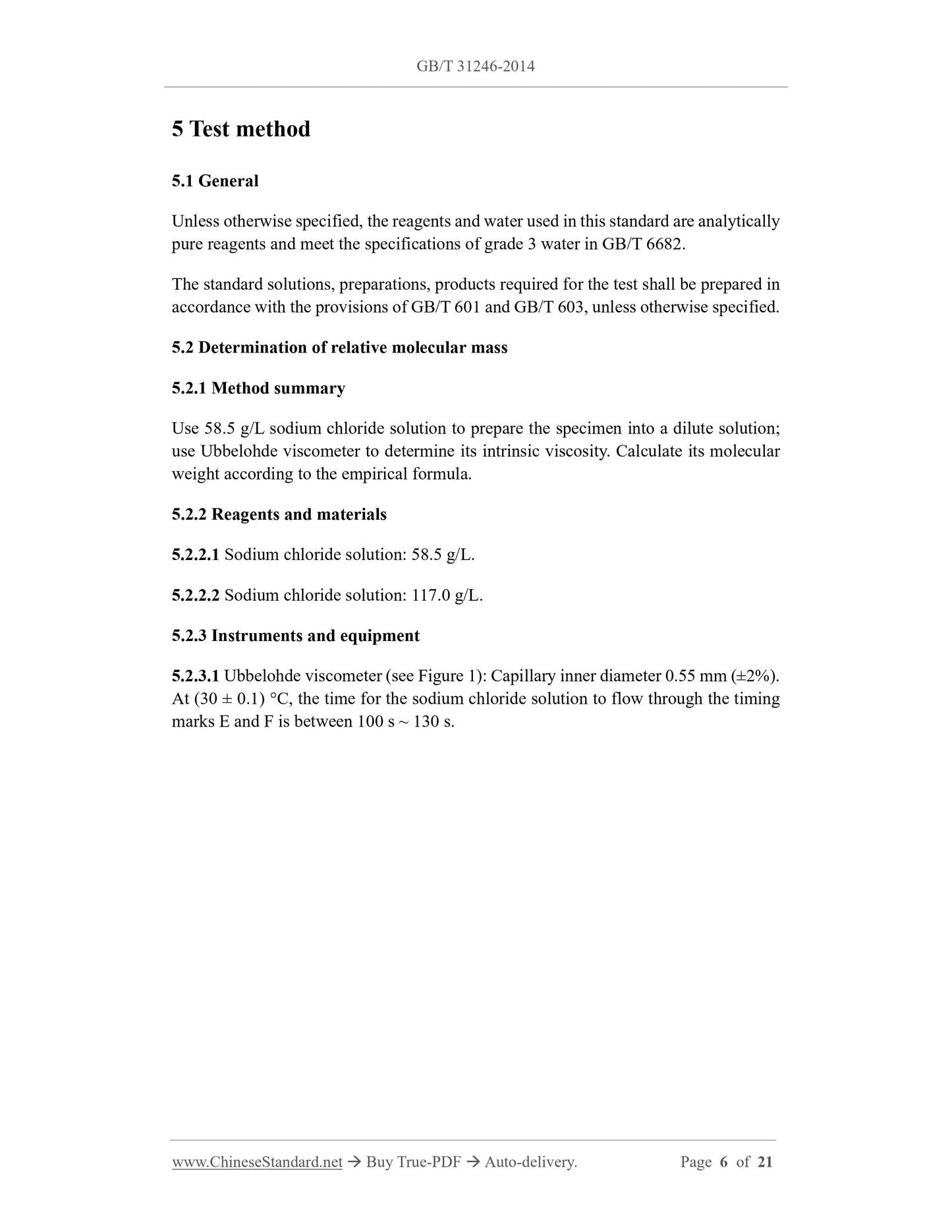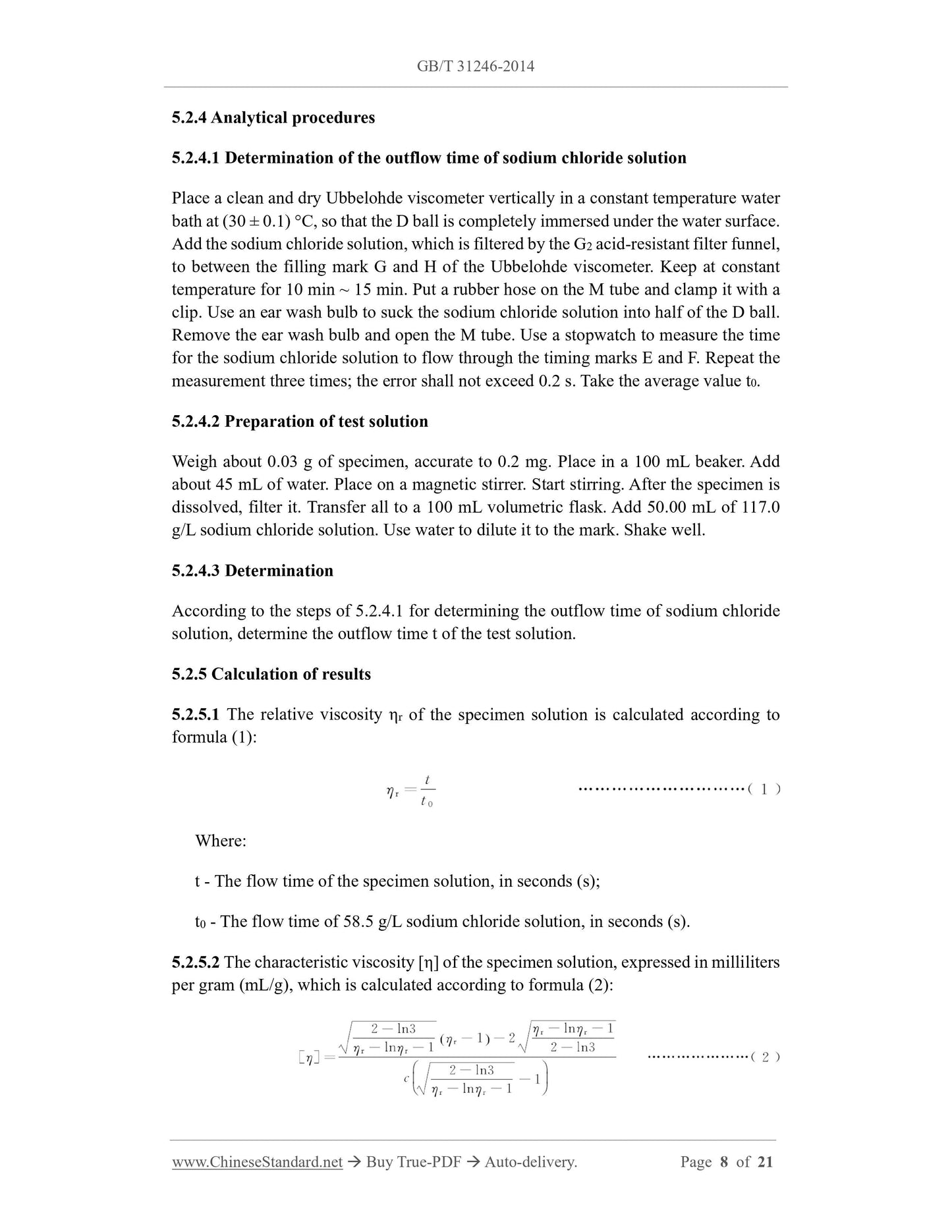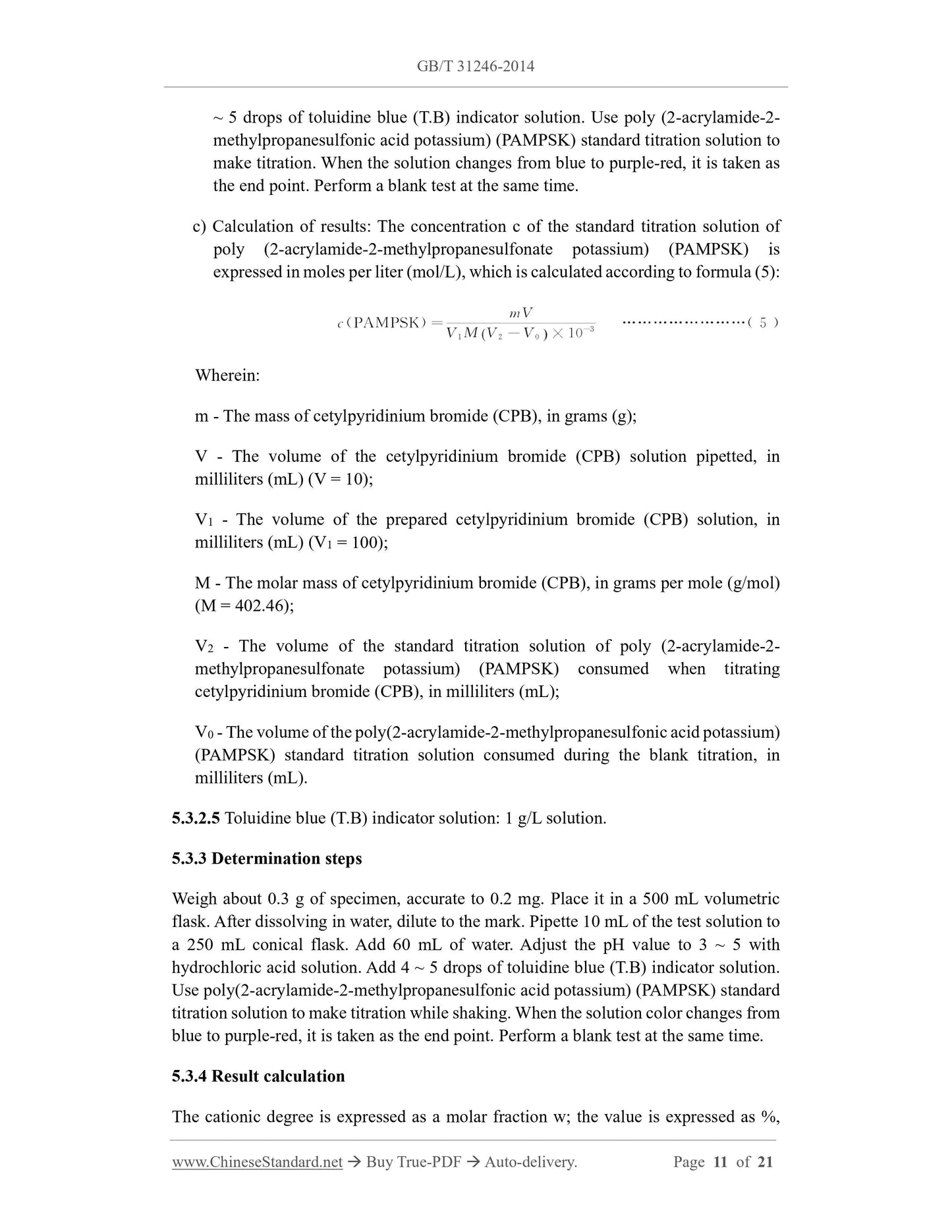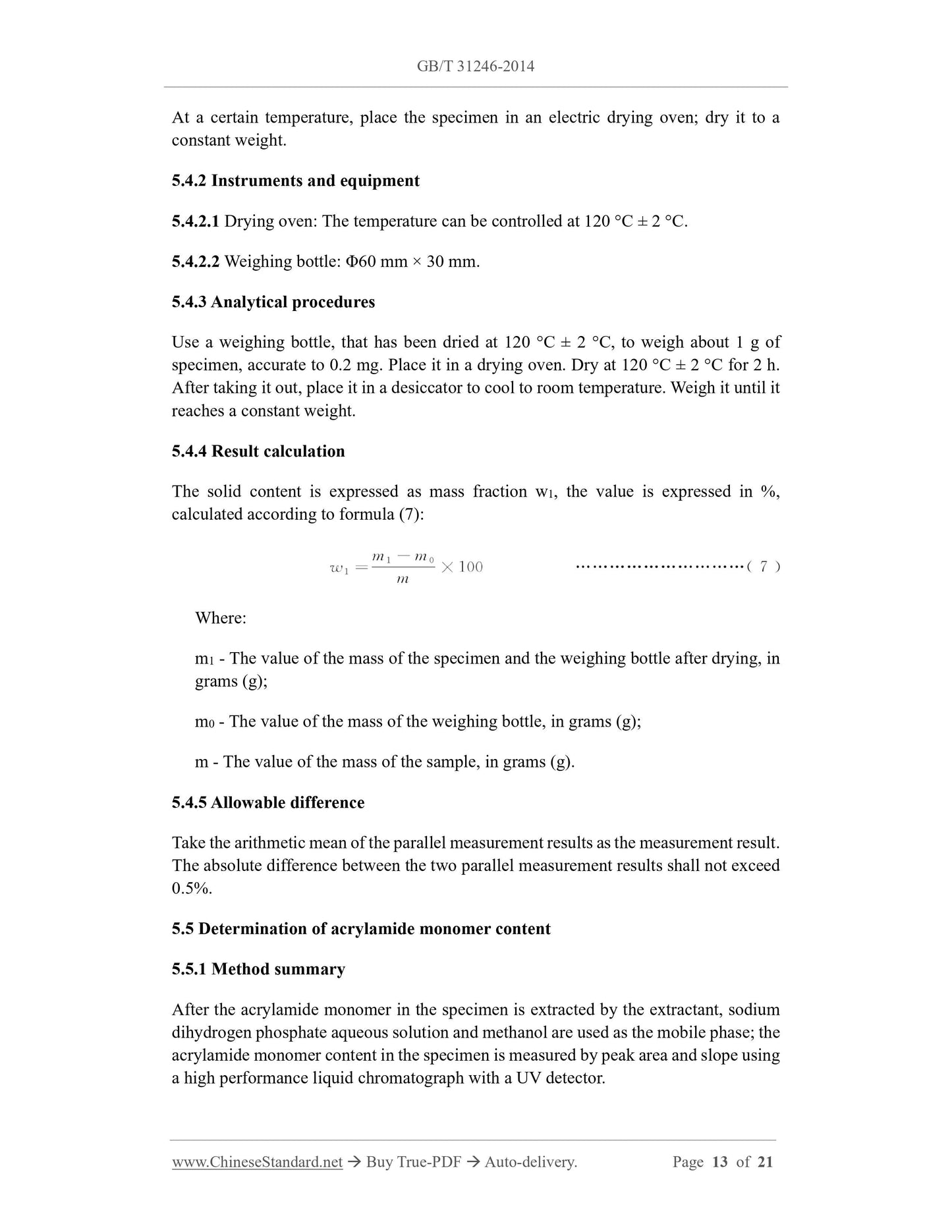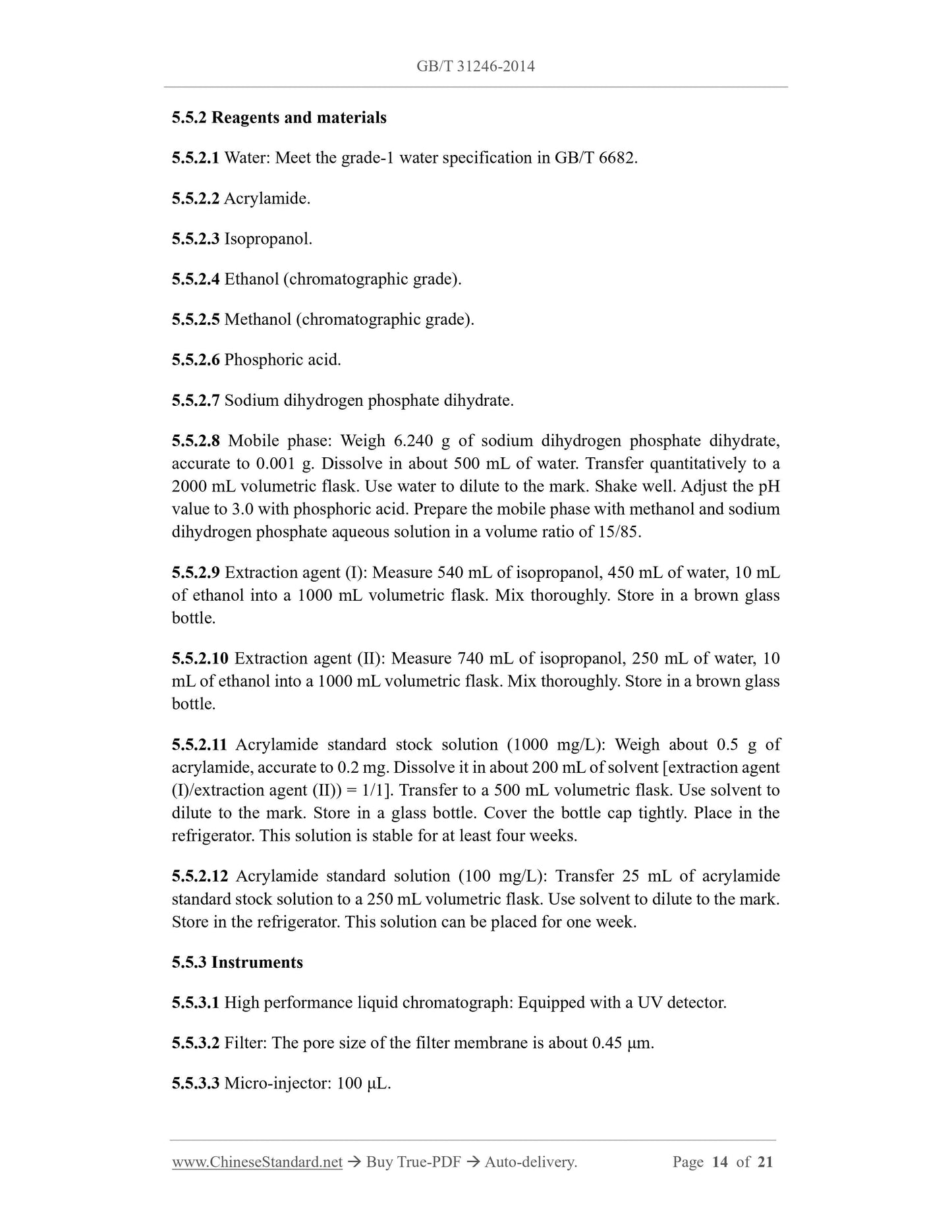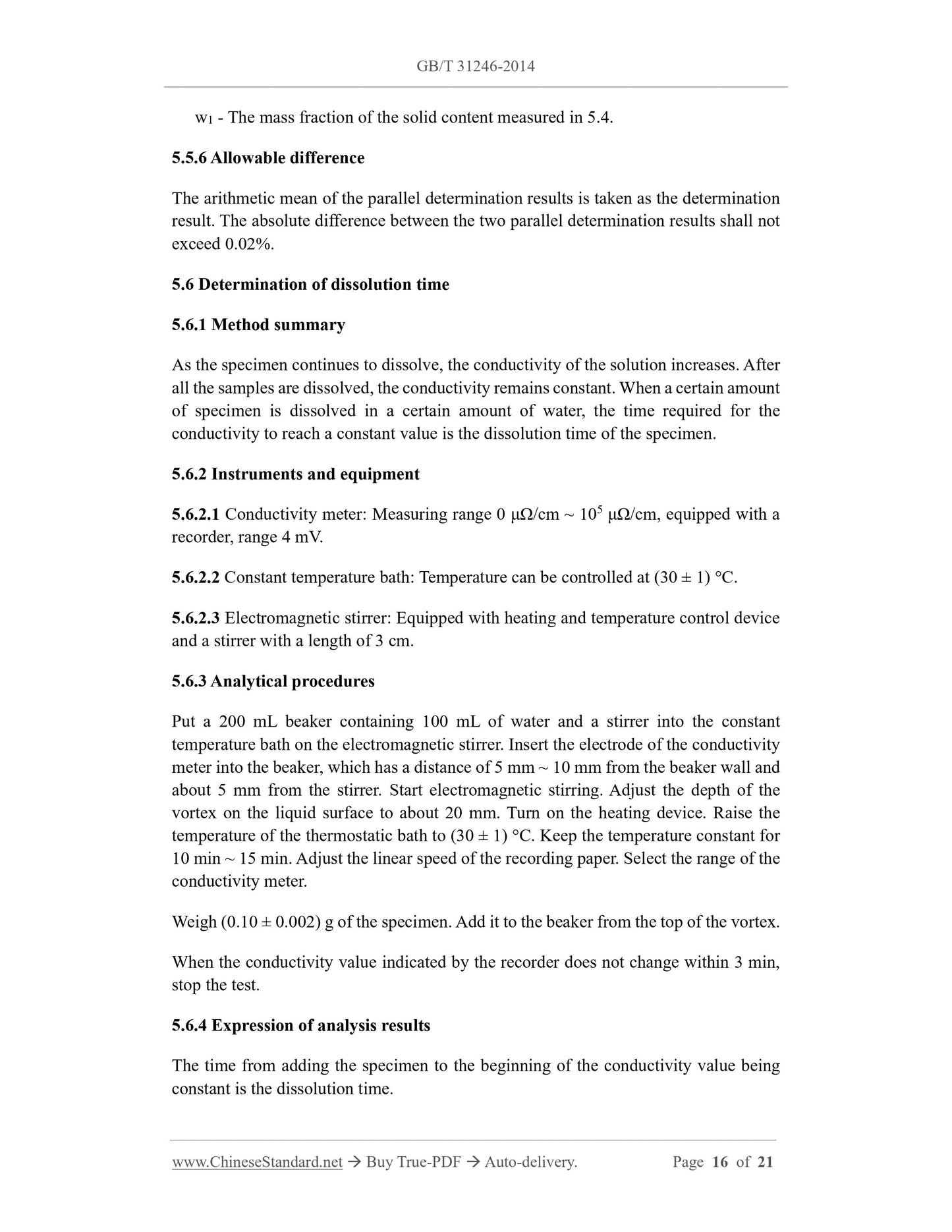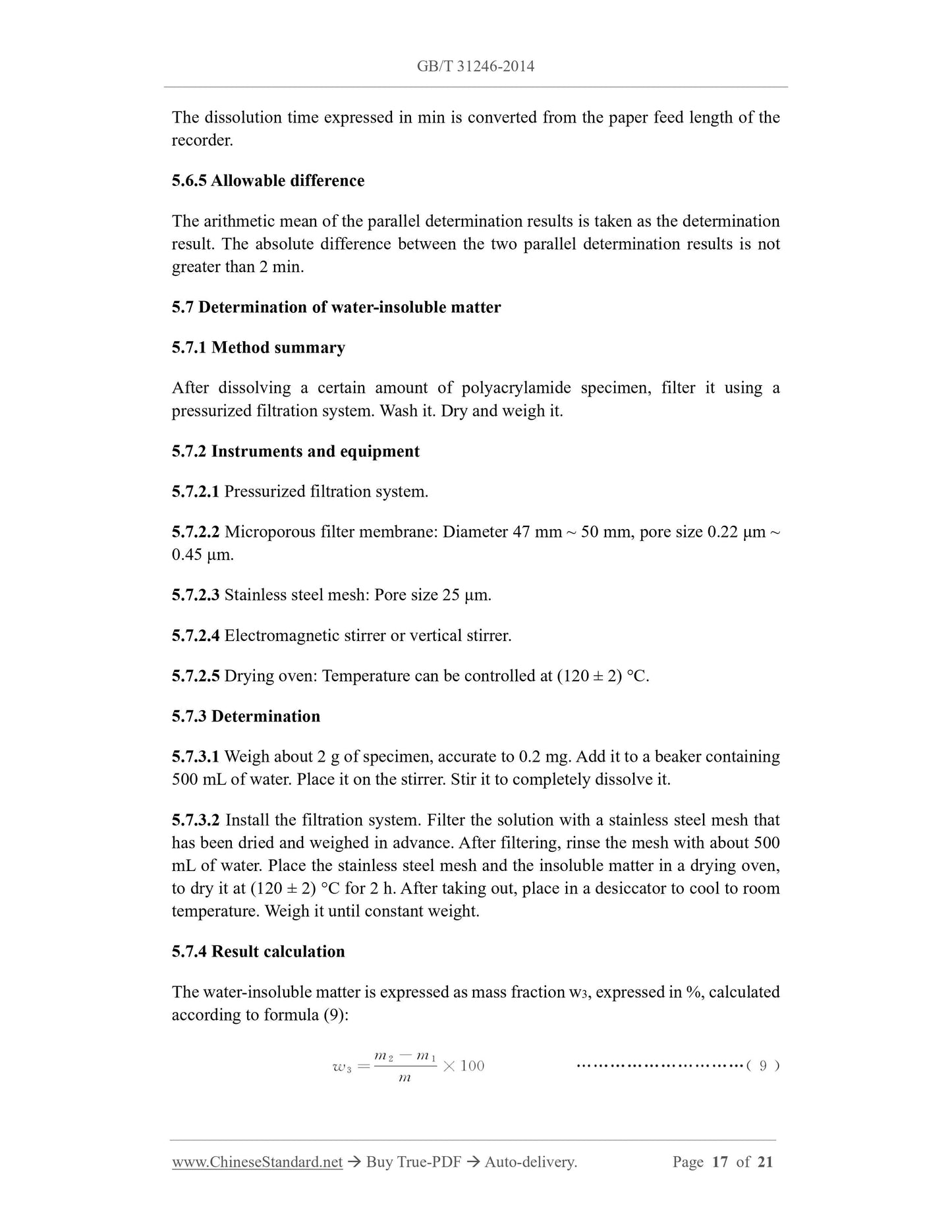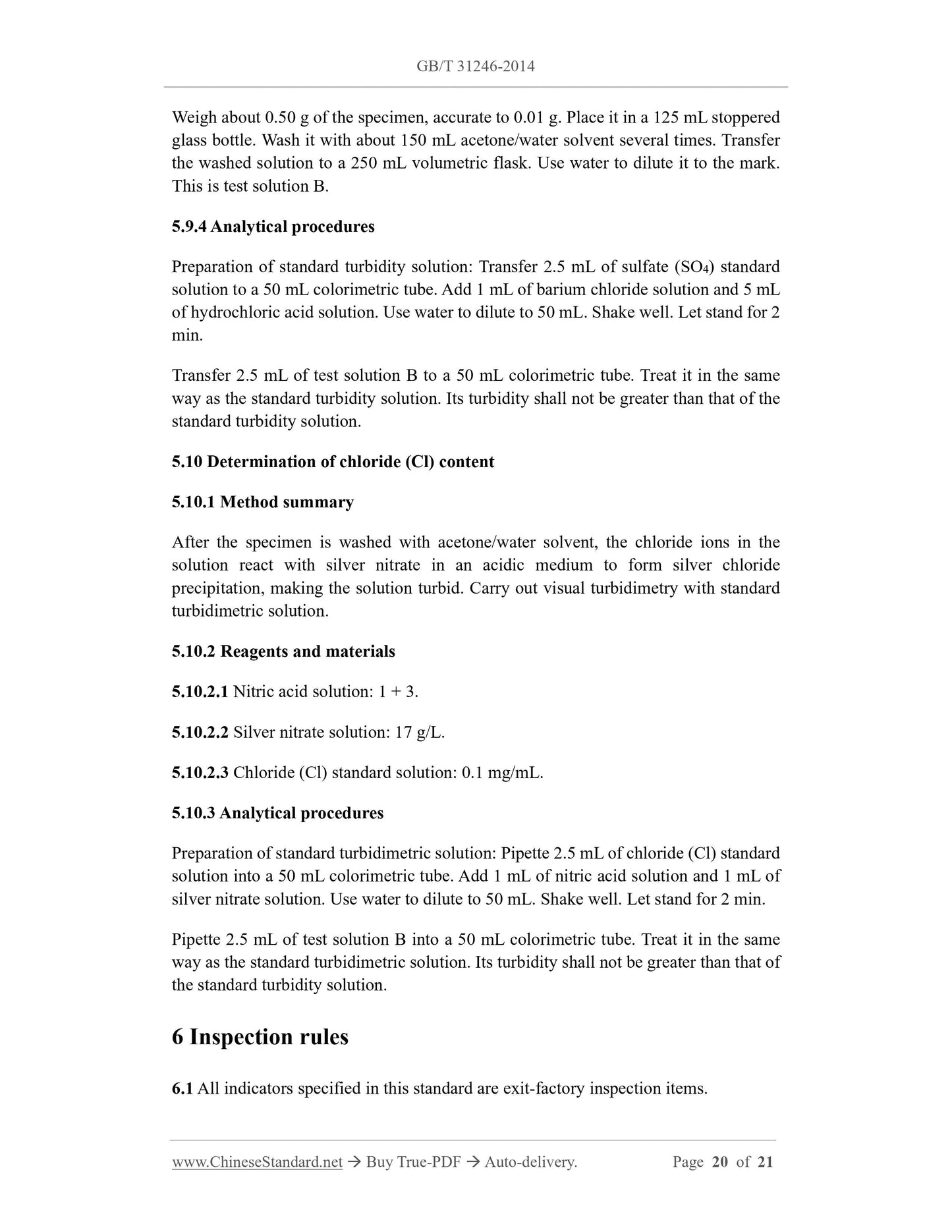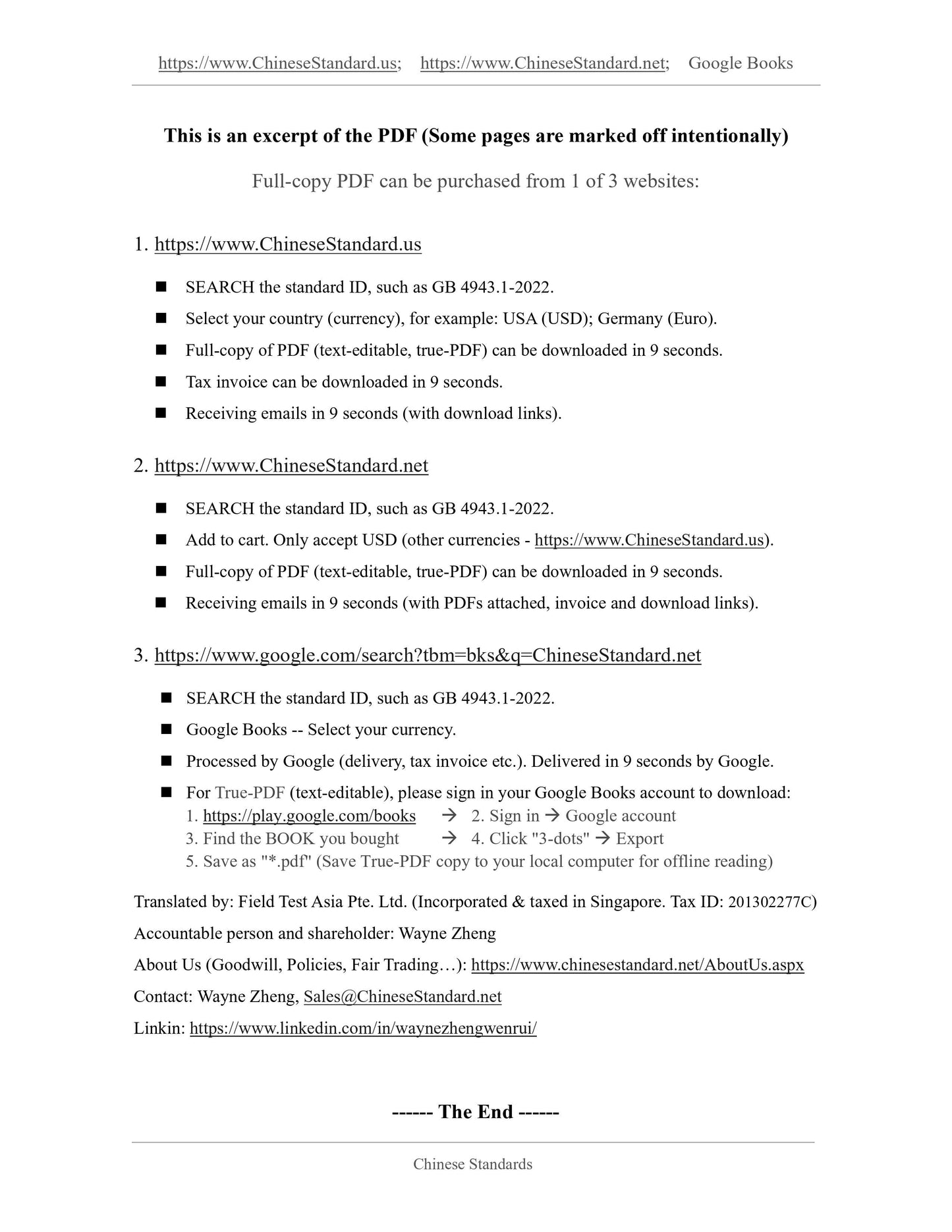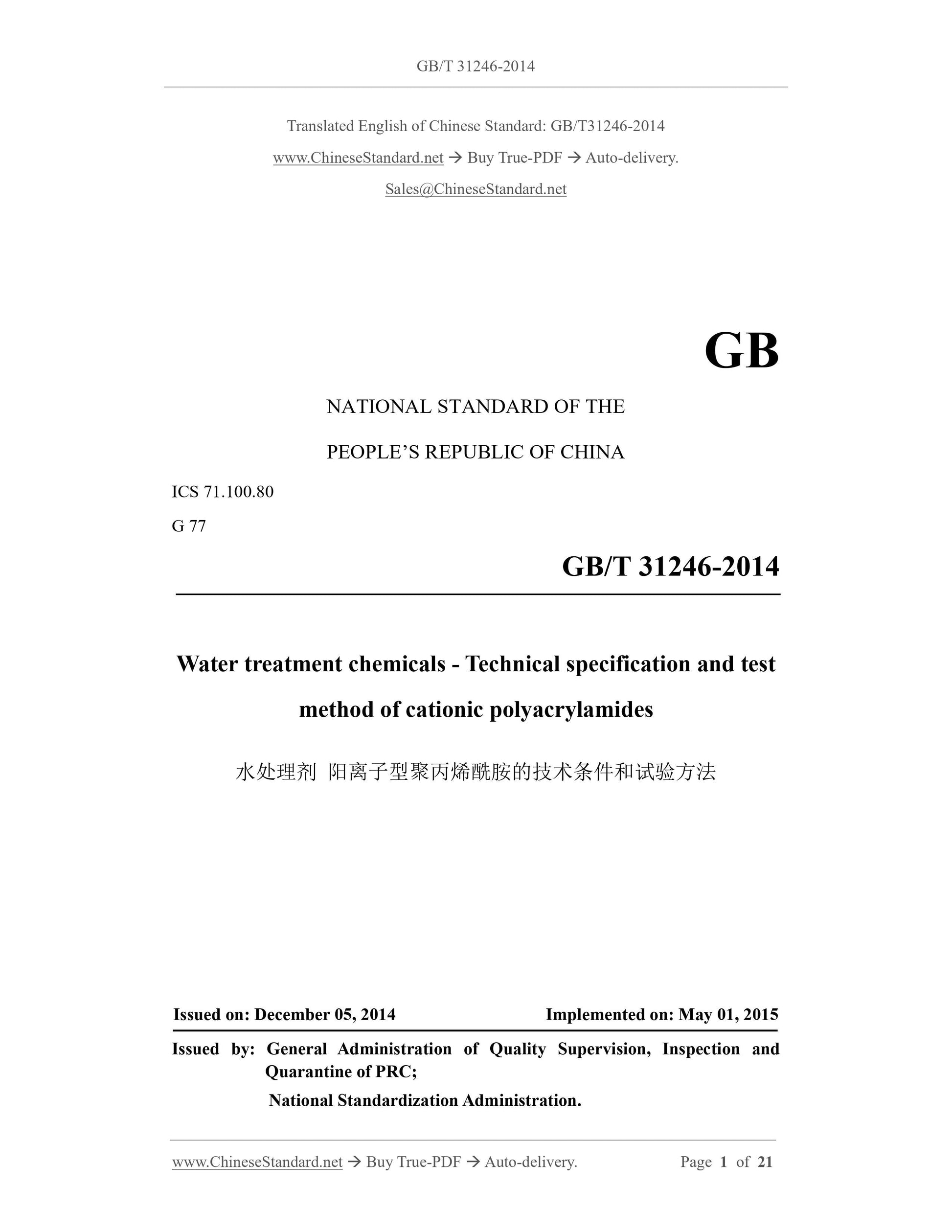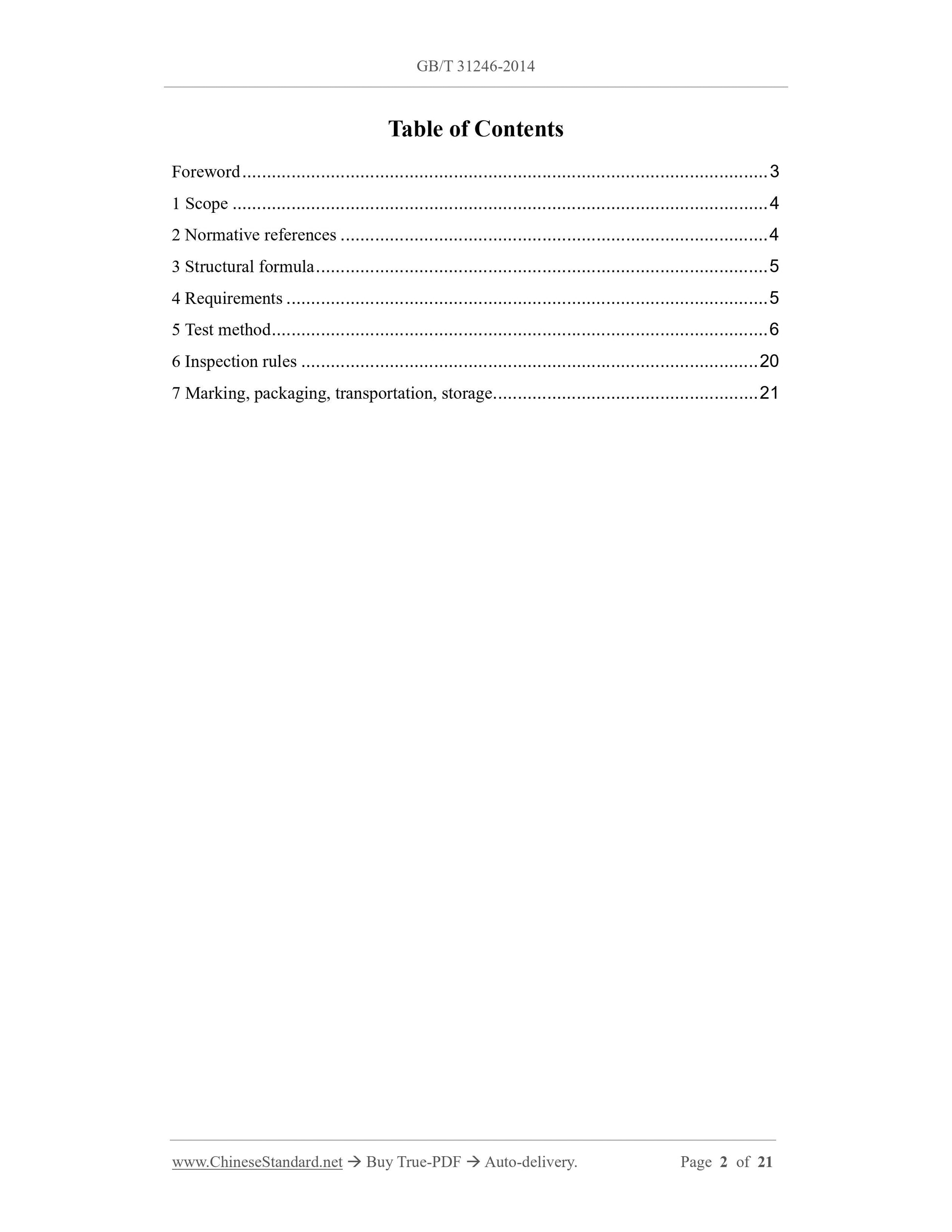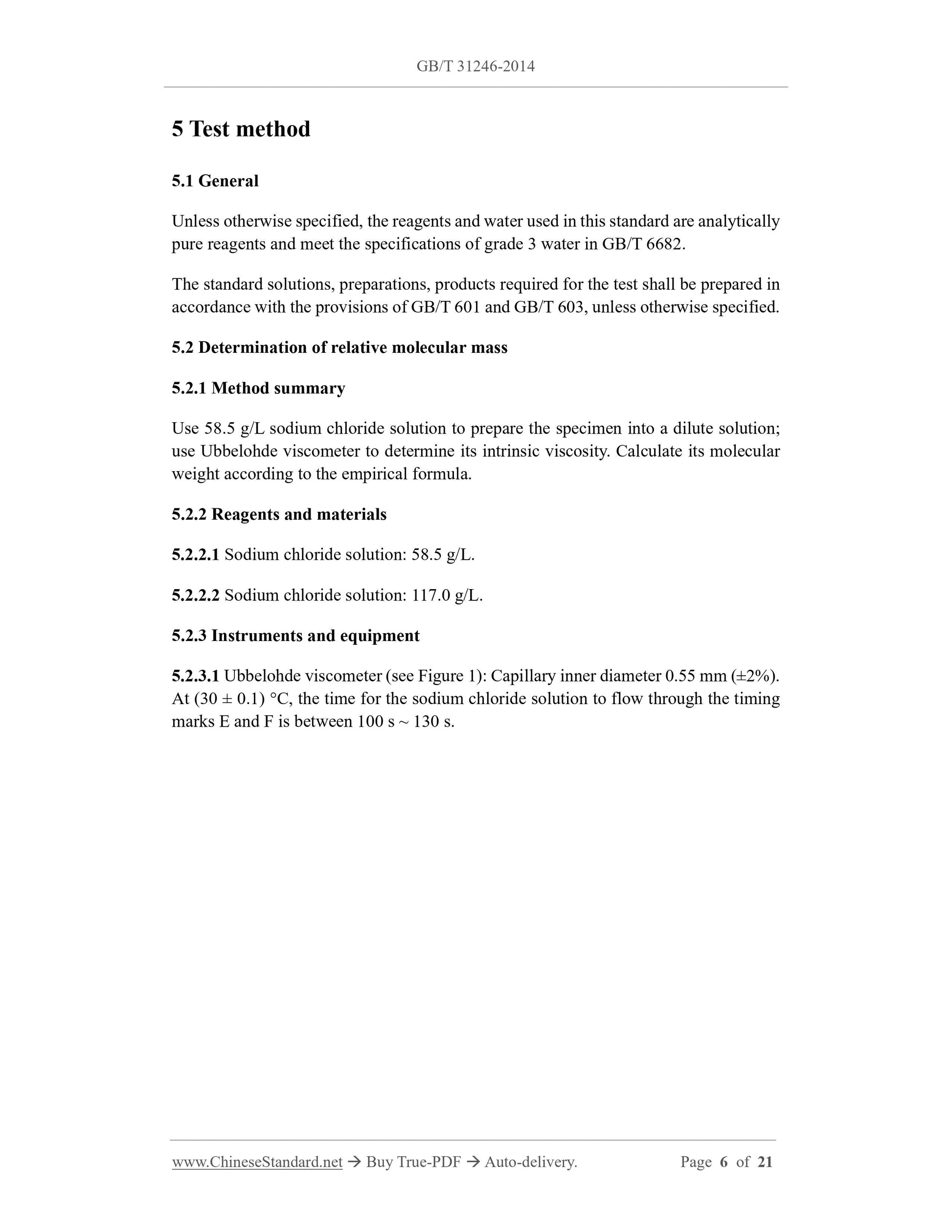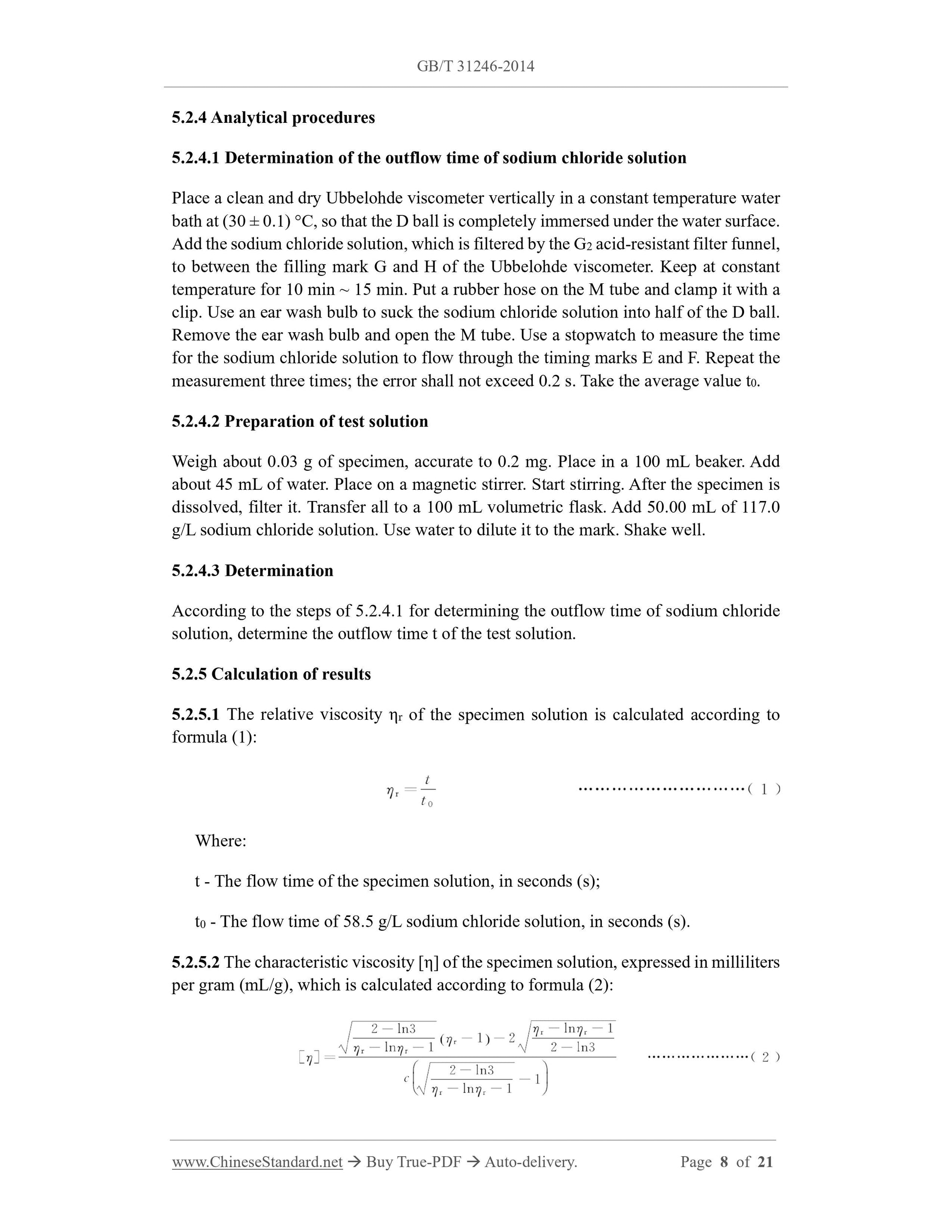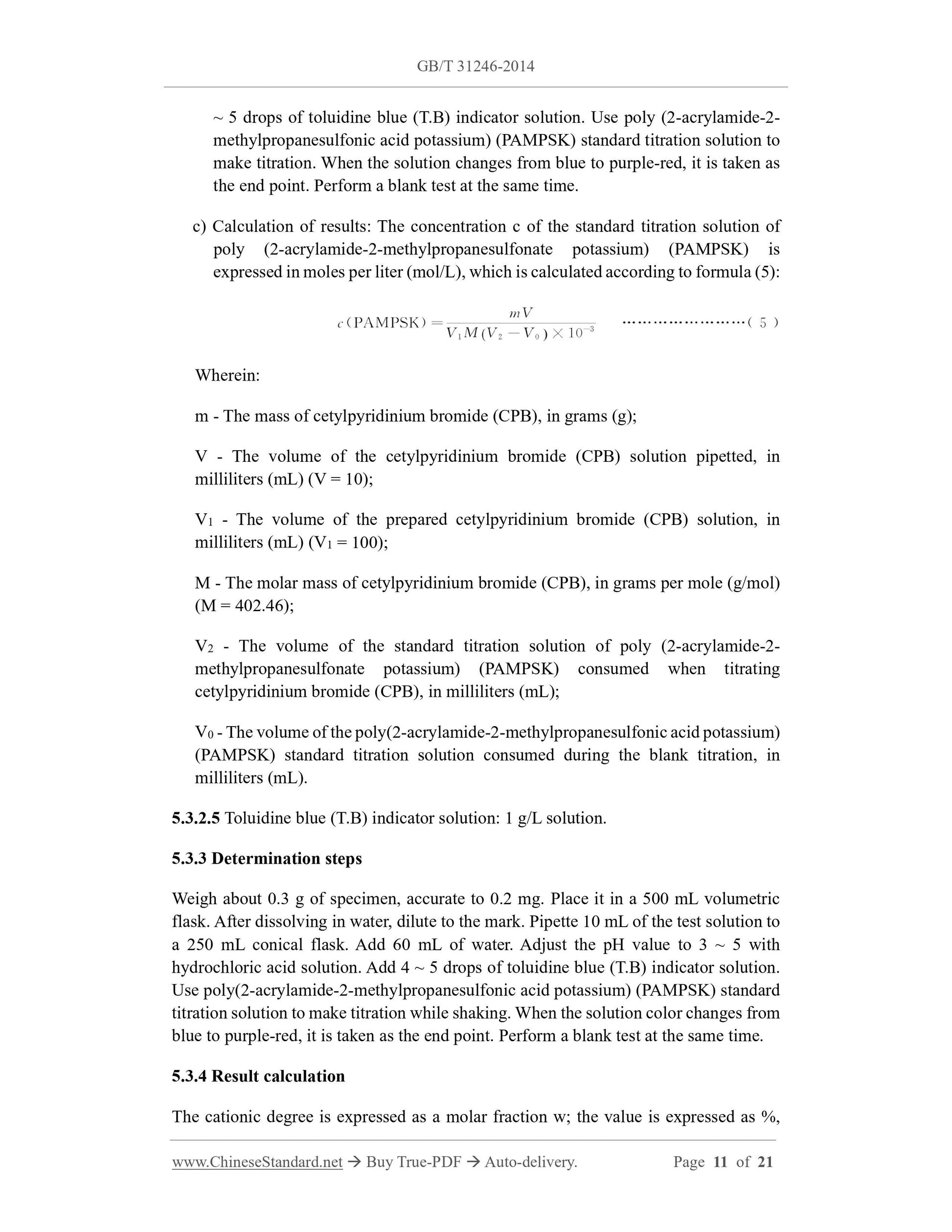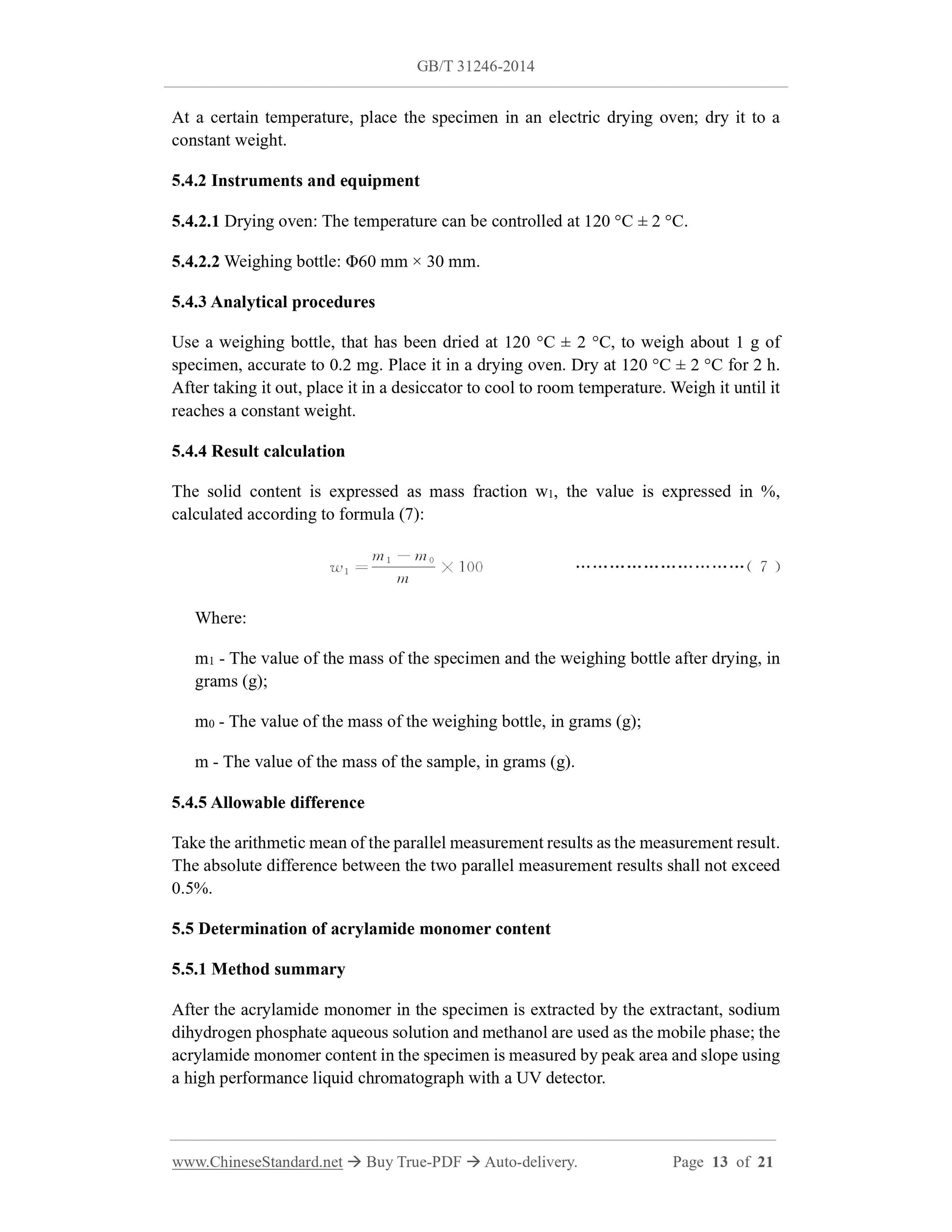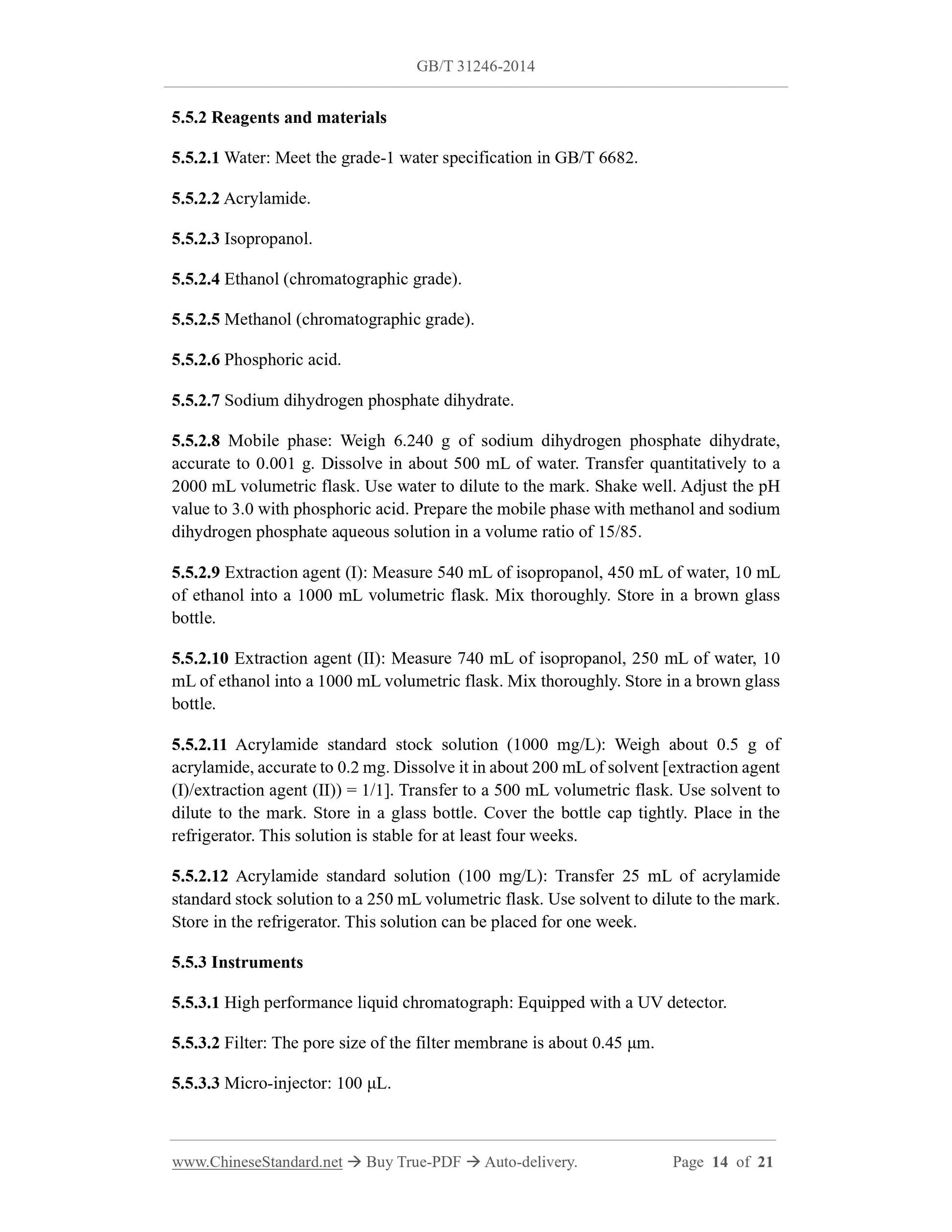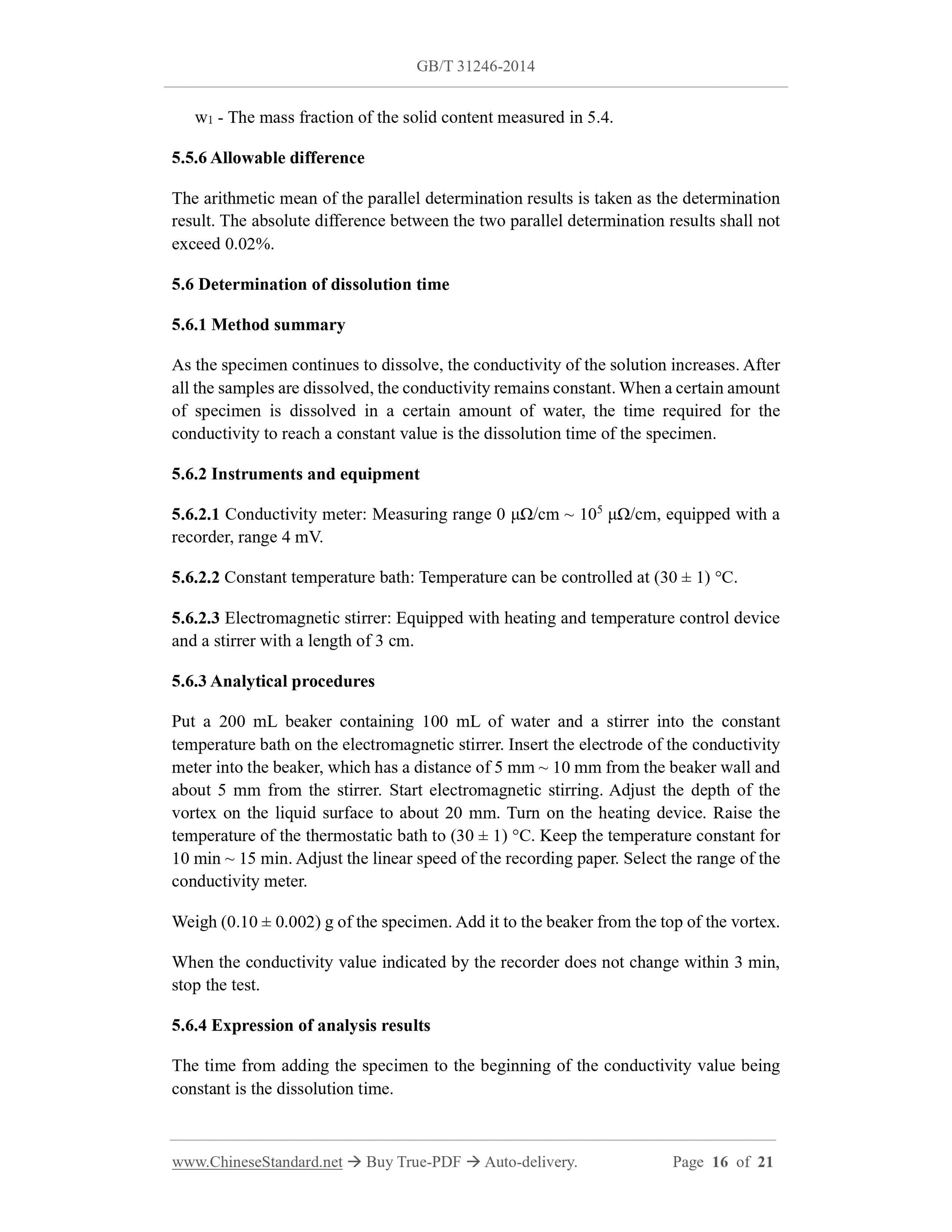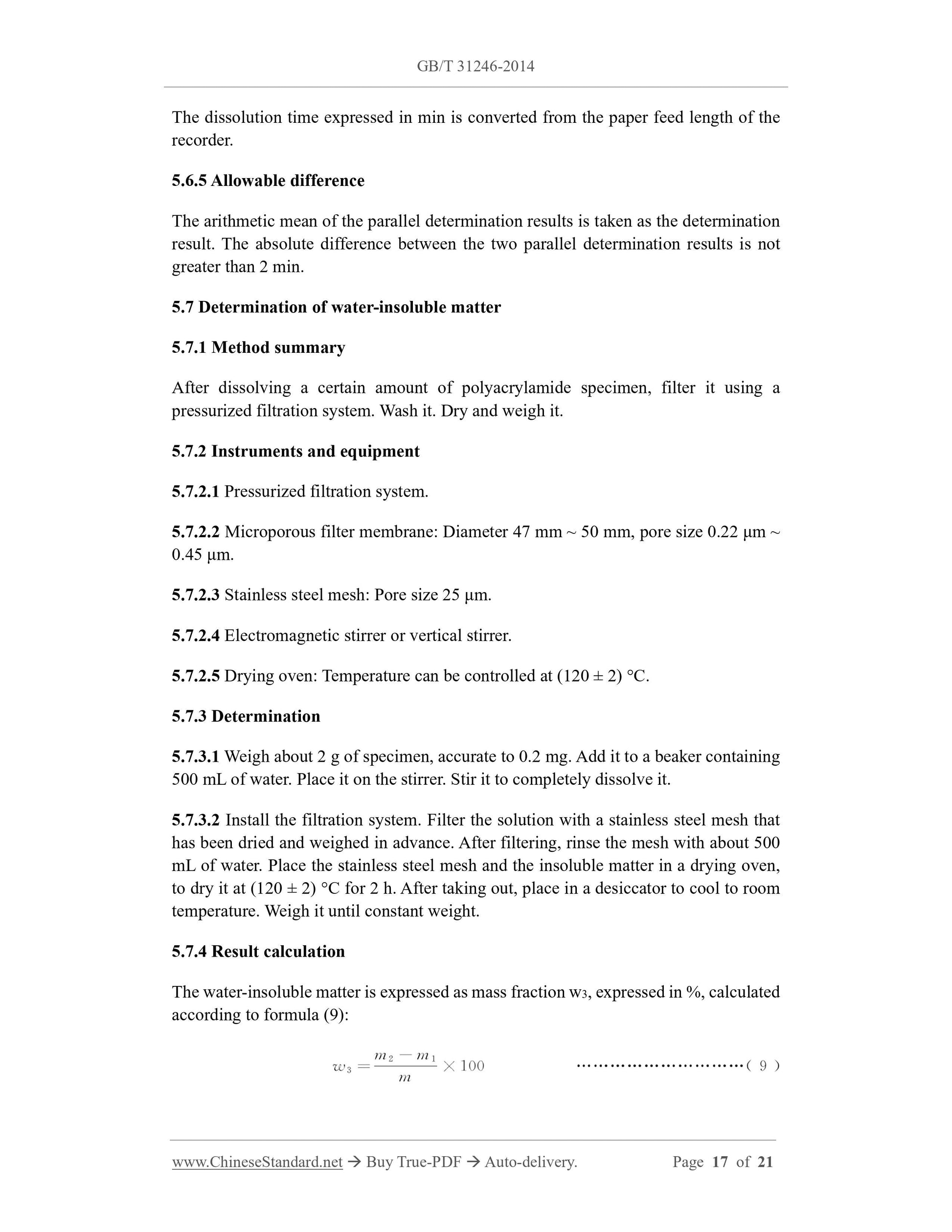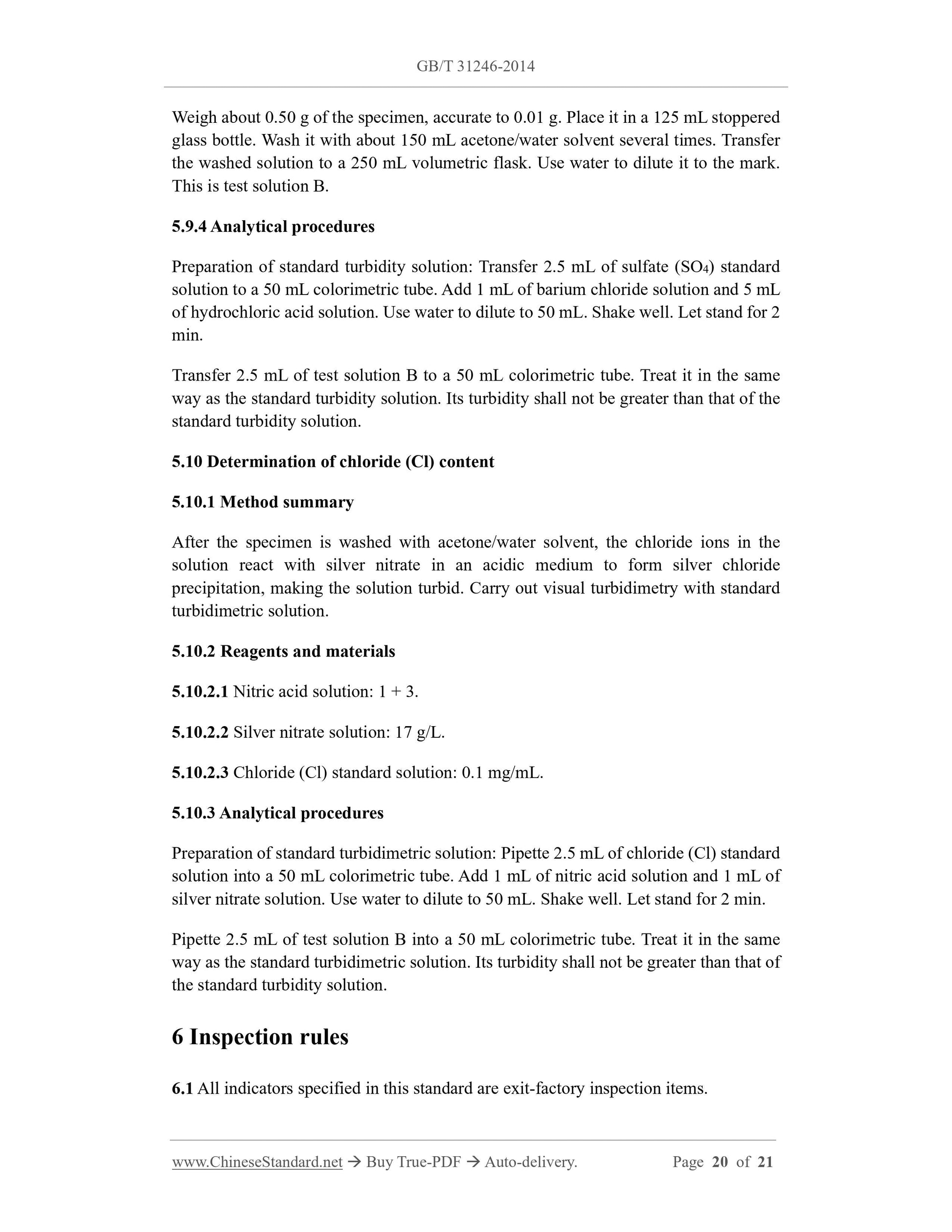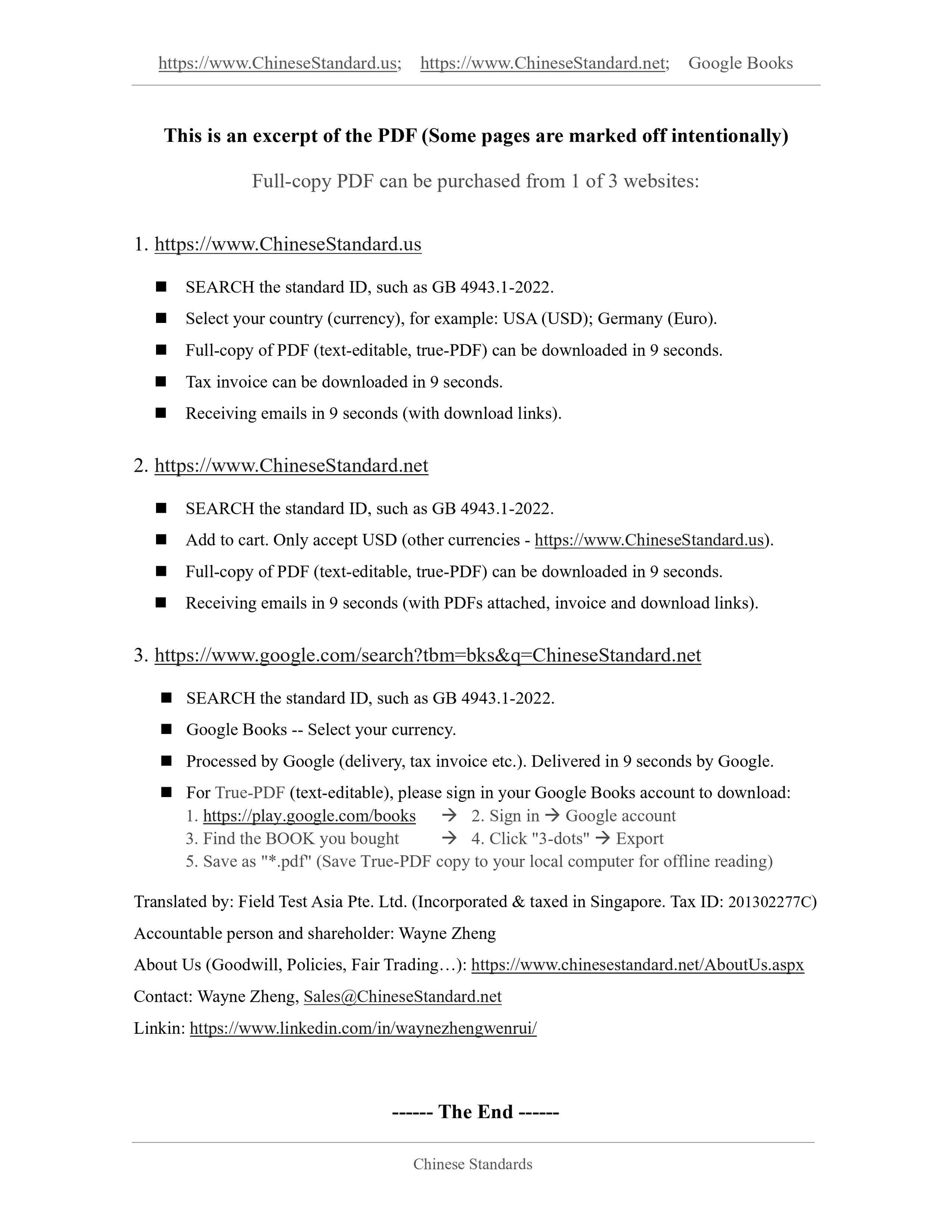1
/
of
12
www.ChineseStandard.us -- Field Test Asia Pte. Ltd.
GB/T 31246-2014 English PDF (GB/T31246-2014)
GB/T 31246-2014 English PDF (GB/T31246-2014)
Regular price
$270.00
Regular price
Sale price
$270.00
Unit price
/
per
Shipping calculated at checkout.
Couldn't load pickup availability
GB/T 31246-2014: Water treatment chemicals - Technical specification and test method of cationic polyacrylamides
Delivery: 9 seconds. Download (& Email) true-PDF + Invoice.
Get Quotation: Click GB/T 31246-2014 (Self-service in 1-minute)
Historical versions (Master-website): GB/T 31246-2014
Preview True-PDF (Reload/Scroll-down if blank)
GB/T 31246-2014
GB
NATIONAL STANDARD OF THE
PEOPLE’S REPUBLIC OF CHINA
ICS 71.100.80
G 77
Water treatment chemicals - Technical specification and test
method of cationic polyacrylamides
ISSUED ON. DECEMBER 05, 2014
IMPLEMENTED ON. MAY 01, 2015
Issued by. General Administration of Quality Supervision, Inspection and
Quarantine of PRC;
National Standardization Administration.
Table of Contents
Foreword... 3
1 Scope... 4
2 Normative references... 4
3 Structural formula... 5
4 Requirements... 5
5 Test method... 6
6 Inspection rules... 20
7 Marking, packaging, transportation, storage... 21
Water treatment chemicals - Technical specification and test
method of cationic polyacrylamides
Warning - The strong acid used in this standard is corrosive and shall be avoided
from inhalation or skin contact when used. If splashed on the body, rinse with
plenty of water immediately; seek medical attention immediately in severe cases.
1 Scope
This standard specifies the requirements, test methods, inspection rules, marking,
packaging, transportation, storage of cationic polyacrylamide.
This standard applies to cationic polyacrylamide products for water treatment agents,
which are mainly used as flocculation for industrial water, wastewater, sewage
treatment, sludge dewatering treatment.
2 Normative references
The following documents are essential to the application of this document. For the dated
documents, only the versions with the dates indicated are applicable to this document;
for the undated documents, only the latest version (including all the amendments) is
applicable to this standard.
GB/T 191 Packaging - Pictorial marking for handling of goods
GB/T 601 Chemical reagent - Preparations of standard volumetric solutions
GB/T 603 Chemical reagent - Preparations of reagent solutions for use in test
methods
GB/T 6003.1 Test sieves - Technical requirements and testing - Part 1.Test sieves
of metal wire cloth
GB/T 6678 General principles for sampling chemical products
GB/T 6682 Water for analytical laboratory use - Specification and test methods
GB/T 8170 Rules of rounding off for numerical values and expression and
judgement of limiting values
5 Test method
5.1 General
Unless otherwise specified, the reagents and water used in this standard are analytically
pure reagents and meet the specifications of grade 3 water in GB/T 6682.
The standard solutions, preparations, products required for the test shall be prepared in
accordance with the provisions of GB/T 601 and GB/T 603, unless otherwise specified.
5.2 Determination of relative molecular mass
5.2.1 Method summary
Use 58.5 g/L sodium chloride solution to prepare the specimen into a dilute solution;
use Ubbelohde viscometer to determine its intrinsic viscosity. Calculate its molecular
weight according to the empirical formula.
5.2.2 Reagents and materials
5.2.2.1 Sodium chloride solution. 58.5 g/L.
5.2.2.2 Sodium chloride solution. 117.0 g/L.
5.2.3 Instruments and equipment
5.2.3.1 Ubbelohde viscometer (see Figure 1). Capillary inner diameter 0.55 mm (±2%).
At (30 ± 0.1) °C, the time for the sodium chloride solution to flow through the timing
marks E and F is between 100 s ~ 130 s.
5.2.4 Analytical procedures
5.2.4.1 Determination of the outflow time of sodium chloride solution
Place a clean and dry Ubbelohde viscometer vertically in a constant temperature water
bath at (30 ± 0.1) °C, so that the D ball is completely immersed under the water surface.
Add the sodium chloride solution, which is filtered by the G2 acid-resistant filter funnel,
to between the filling mark G and H of the Ubbelohde viscometer. Keep at constant
temperature for 10 min ~ 15 min. Put a rubber hose on the M tube and clamp it with a
clip. Use an ear wash bulb to suck the sodium chloride solution into half of the D ball.
Remove the ear wash bulb and open the M tube. Use a stopwatch to measure the time
for the sodium chloride solution to flow through the timing marks E and F. Repeat the
measurement three times; the error shall not exceed 0.2 s. Take the average value t0.
5.2.4.2 Preparation of test solution
Weigh about 0.03 g of specimen, accurate to 0.2 mg. Place in a 100 mL beaker. Add
about 45 mL of water. Place on a magnetic stirrer. Start stirring. After the specimen is
dissolved, filter it. Transfer all to a 100 mL volumetric flask. Add 50.00 mL of 117.0
g/L sodium chloride solution. Use water to dilute it to the mark. Shake well.
5.2.4.3 Determination
According to the steps of 5.2.4.1 for determining the outflow time of sodium chloride
solution, determine the outflow time t of the test solution.
5.2.5 Calculation of results
5.2.5.1 The relative viscosity ηr of the specimen solution is calculated according to
formula (1).
Where.
t - The flow time of the specimen solution, in seconds (s);
t0 - The flow time of 58.5 g/L sodium chloride solution, in seconds (s).
5.2.5.2 The characteristic viscosity [η] of the specimen solution, expressed in milliliters
per gram (mL/g), which is calculated according to formula (2).
~ 5 drops of toluidine blue (T.B) indicator solution. Use poly (2-acrylamide-2-
methylpropanesulfonic acid potassium) (PAMPSK) standard titration solution to
make titration. When the solution changes from blue to purple-red, it is taken as
the end point. Perform a blank test at the same time.
c) Calculation of results. The concentration c of the standard titration solution of
poly (2-acrylamide-2-methylpropanesulfonate potassium) (PAMPSK) is
expressed in moles per liter (mol/L), which is calculated according to formula (5).
Wherein.
m - The mass of cetylpyridinium bromide (CPB), in grams (g);
V - The volume of the cetylpyridinium bromide (CPB) solution pipetted, in
milliliters (mL) (V = 10);
V1 - The volume of the prepared cetylpyridinium bromide (CPB) solution, in
milliliters (mL) (V1 = 100);
M - The molar mass of cetylpyridinium bromide (CPB), in grams per mole (g/mol)
(M = 402.46);
V2 - The volume of the standard titration solution of poly (2-acrylamide-2-
methylpropanesulfonate potassium) (PAMPSK) consumed when titrating
cetylpyridinium bromide (CPB), in milliliters (mL);
V0 - The volume of the poly(2-acrylamide-2-methylpropanesulfonic acid potassium)
(PAMPSK) standard titration solution consumed during the blank titration, in
milliliters (mL).
5.3.2.5 Toluidine blue (T.B) indicator solution. 1 g/L solution.
5.3.3 Determination steps
Weigh about 0.3 g of specimen, accurate to 0.2 mg. Place it in a 500 mL volumetric
flask. After dissolving in water, dilute to the mark. Pipette 10 mL of the test solution to
a 250 mL conical flask. Add 60 mL of water. Adjust the pH value to 3 ~ 5 with
hydrochloric acid solution. Add 4 ~ 5 drops of toluidine blue (T.B) indicator solution.
Use poly(2-acrylamide-2-methylpropanesulfonic acid potassium) (PAMPSK) standard
titration solution to make titration while shaking. When the solution color changes from
blue to purple-red, it is taken as the end point. Perform a blank test at the same time.
5.3.4 Result calculation
The cationic degree is expressed as a molar fraction w; the value is expressed as %,
At a certain temperature, place the specimen in an electric drying oven; dry it to a
constant weight.
5.4.2 Instruments and equipment
5.4.2.1 Drying oven. The temperature can be controlled at 120 °C ± 2 °C.
5.4.2.2 Weighing bottle. Φ60 mm × 30 mm.
5.4.3 Analytical procedures
Use a weighing bottle, that has been dried at 120 °C ± 2 °C, to weigh about 1 g of
specimen, accurate to 0.2 mg. Place it in a drying oven. Dry at 120 °C ± 2 °C for 2 h.
After taking it out, place it in a desiccator to cool to room temperature. Weigh it until it
reaches a constant weight.
5.4.4 Result calculation
The solid content is expressed as mass fraction w1, the value is expressed in %,
calculated according to formula (7).
Where.
m1 - The value of the mass of the specimen and the weighing bottle after drying, in
grams (g);
m0 - The value of the mass of the weighing bottle, in grams (g);
m - The value of the mass of the sample, in grams (g).
5.4.5 Allowable difference
Take the arithmetic mean of the parallel measurement results as the measurement result.
The absolute difference between the two parallel measurement results shall not exceed
0.5%.
5.5 Determination of acrylamide monomer content
5.5.1 Method summary
After the acrylamide monomer in the specimen is extracted by the extractant, sodium
dihydrogen phosphate aqueous solution and methanol are used as the mobile phase; the
acrylamide monomer content in the specimen is measured by peak area and slope using
a high performance liquid chromatograph with a UV detector.
5.5.2 Reagents and materials
5.5.2.1 Water. Meet the grade-1 water specification in GB/T 6682.
5.5.2.2 Acrylamide.
5.5.2.3 Isopropanol.
5.5.2.4 Ethanol (chromatographic grade).
5.5.2.5 Methanol (chromatographic grade).
5.5.2.6 Phosphoric acid.
5.5.2.7 Sodium dihydrogen phosphate dihydrate.
5.5.2.8 Mobile phase. Weigh 6.240 g of sodium dihydrogen phosphate dihydrate,
accurate to 0.001 g. Dissolve in about 500 mL of water. Transfer quantitatively to a
2000 mL volumetric flask. Use water to dilute to the mark. Shake well. Adjust the pH
value to 3.0 with phosphoric acid. Prepare the mobile phase with methanol and sodium
dihydrogen phosphate aqueous solution in a volume ratio of 15/85.
5.5.2.9 Extraction agent (I). Measure 540 mL of isopropanol, 450 mL of water, 10 mL
of ethanol into a 1000 mL volumetric flask. Mix thoroughly. Store in a brown glass
bottle.
5.5.2.10 Extraction agent (II). Measure 740 mL of isopropanol, 250 mL of water, 10
mL of ethanol into a 1000 mL volumetric flask. Mix thoroughly. Store in a brown glass
bottle.
5.5.2.11 Acrylamide standard stock solution (1000 mg/L). Weigh about 0.5 g of
acrylamide, accurate to 0.2 mg. Dissolve it in about 200 mL of solvent [extraction agent
(I)/extraction agent (II)) = 1/1]. Transfer to a 500 mL volumetric flask. Use solvent to
dilute to the mark. Store in a glass bottle. Cover the bottle cap tightly. Place in the
refrigerator. This solution is stable for at least four weeks.
5.5.2.12 Acrylamide standard solution (100 mg/L). Transfer 25 mL of acrylamide
standard stock solution to a 250 mL volumetric flask. Use solvent to dilute to the mark.
Store in the refrigerator. This solution can be placed for one week.
5.5.3 Instruments
5.5.3.1 High performance liquid chromatograph. Equipped with a UV detector.
5.5.3.2 Filter. The pore size of the filter membrane is about 0.45 μm.
5.5.3.3 Micro-injector. 100 μL.
w1 - The mass fraction of the solid content measured in 5.4.
5.5.6 Allowable difference
The arithmetic mean of the parallel determination results is taken as the determination
result. The absolute difference between the two parallel determination results shall not
exceed 0.02%.
5.6 Determination of dissolution time
5.6.1 Method summary
As the specimen continues to dissolve, the conductivity of the solution increases. After
all the samples are dissolved, the conductivity remains constant. When a certain amount
of specimen is dissolved in a certain amount of water, the time required for the
conductivity to reach a constant value is the dissolution time of the specimen.
5.6.2 Instruments and equipment
5.6.2.1 Conductivity meter. Measuring range 0 μΩ/cm ~ 105 μΩ/cm, equipped with a
recorder, range 4 mV.
5.6.2.2 Constant temperature bath. Temperature can be controlled at (30 ± 1) °C.
5.6.2.3 Electromagnetic stirrer. Equipped with heating and temperature control device
and a stirrer with a length of 3 cm.
5.6.3 Analytical procedures
Put a 200 mL beaker containing 100 mL of water and a stirrer into the constant
temperature bath on the electromagnetic stirrer. Insert the electrode of the conductivity
meter into the beaker, which has a distance of 5 mm ~ 10 mm from the beaker wall and
about 5 mm from the stirrer. Start electromagnetic stirring. Adjust the depth of the
vortex on the liquid surface to about 20 mm. Turn on the heating device. Raise the
temperature of the thermostatic bath to (30 ± 1) °C. Keep the temperature constant for
10 min ~ 15 min. Adjust the linear speed of the recording paper. Select the range of the
conductivity meter.
Weigh (0.10 ± 0.002) g of the specimen. Add it to the beaker from the top of the vortex.
When the conductivity value indicated by the recorder does not change within 3 min,
stop the test.
5.6.4 Expression of analysis results
The time from adding the specimen to the beginning of the conductivity value being
constant is the dissolution time.
The dissolution time expressed in min is converted from the paper feed length of the
recorder.
5.6.5 Allowable difference
The arithmetic mean of the parallel determination results is taken as the determination
result. The absolute difference between the two parallel determination results is not
greater than 2 min.
5.7 Determination of water-insoluble matter
5.7.1 Method summary
After dissolving a certain amount of polyacrylamide specimen, filter it using a
pressurized filtration system. Wash it. Dry and weigh it.
5.7.2 Instruments and equipment
5.7.2.1 Pressurized filtration system.
5.7.2.2 Microporous filter membrane. Diameter 47 mm ~ 50 mm, pore size 0.22 μm ~
0.45 μm.
5.7.2.3 Stainless steel mesh. Pore size 25 μm.
5.7.2.4 Electromagnetic stirrer or vertical stirrer.
5.7.2.5 Drying oven. Temperature can be controlled at (120 ± 2) °C.
5.7.3 Determination
5.7.3.1 Weigh about 2 g of specimen, accurate to 0.2 mg. Add it to a beaker containing
500 mL of water. Place it on the stirrer. Stir it to completely dissolve it.
5.7.3.2 Install the filtration system. Filter the solution with ...
Delivery: 9 seconds. Download (& Email) true-PDF + Invoice.
Get Quotation: Click GB/T 31246-2014 (Self-service in 1-minute)
Historical versions (Master-website): GB/T 31246-2014
Preview True-PDF (Reload/Scroll-down if blank)
GB/T 31246-2014
GB
NATIONAL STANDARD OF THE
PEOPLE’S REPUBLIC OF CHINA
ICS 71.100.80
G 77
Water treatment chemicals - Technical specification and test
method of cationic polyacrylamides
ISSUED ON. DECEMBER 05, 2014
IMPLEMENTED ON. MAY 01, 2015
Issued by. General Administration of Quality Supervision, Inspection and
Quarantine of PRC;
National Standardization Administration.
Table of Contents
Foreword... 3
1 Scope... 4
2 Normative references... 4
3 Structural formula... 5
4 Requirements... 5
5 Test method... 6
6 Inspection rules... 20
7 Marking, packaging, transportation, storage... 21
Water treatment chemicals - Technical specification and test
method of cationic polyacrylamides
Warning - The strong acid used in this standard is corrosive and shall be avoided
from inhalation or skin contact when used. If splashed on the body, rinse with
plenty of water immediately; seek medical attention immediately in severe cases.
1 Scope
This standard specifies the requirements, test methods, inspection rules, marking,
packaging, transportation, storage of cationic polyacrylamide.
This standard applies to cationic polyacrylamide products for water treatment agents,
which are mainly used as flocculation for industrial water, wastewater, sewage
treatment, sludge dewatering treatment.
2 Normative references
The following documents are essential to the application of this document. For the dated
documents, only the versions with the dates indicated are applicable to this document;
for the undated documents, only the latest version (including all the amendments) is
applicable to this standard.
GB/T 191 Packaging - Pictorial marking for handling of goods
GB/T 601 Chemical reagent - Preparations of standard volumetric solutions
GB/T 603 Chemical reagent - Preparations of reagent solutions for use in test
methods
GB/T 6003.1 Test sieves - Technical requirements and testing - Part 1.Test sieves
of metal wire cloth
GB/T 6678 General principles for sampling chemical products
GB/T 6682 Water for analytical laboratory use - Specification and test methods
GB/T 8170 Rules of rounding off for numerical values and expression and
judgement of limiting values
5 Test method
5.1 General
Unless otherwise specified, the reagents and water used in this standard are analytically
pure reagents and meet the specifications of grade 3 water in GB/T 6682.
The standard solutions, preparations, products required for the test shall be prepared in
accordance with the provisions of GB/T 601 and GB/T 603, unless otherwise specified.
5.2 Determination of relative molecular mass
5.2.1 Method summary
Use 58.5 g/L sodium chloride solution to prepare the specimen into a dilute solution;
use Ubbelohde viscometer to determine its intrinsic viscosity. Calculate its molecular
weight according to the empirical formula.
5.2.2 Reagents and materials
5.2.2.1 Sodium chloride solution. 58.5 g/L.
5.2.2.2 Sodium chloride solution. 117.0 g/L.
5.2.3 Instruments and equipment
5.2.3.1 Ubbelohde viscometer (see Figure 1). Capillary inner diameter 0.55 mm (±2%).
At (30 ± 0.1) °C, the time for the sodium chloride solution to flow through the timing
marks E and F is between 100 s ~ 130 s.
5.2.4 Analytical procedures
5.2.4.1 Determination of the outflow time of sodium chloride solution
Place a clean and dry Ubbelohde viscometer vertically in a constant temperature water
bath at (30 ± 0.1) °C, so that the D ball is completely immersed under the water surface.
Add the sodium chloride solution, which is filtered by the G2 acid-resistant filter funnel,
to between the filling mark G and H of the Ubbelohde viscometer. Keep at constant
temperature for 10 min ~ 15 min. Put a rubber hose on the M tube and clamp it with a
clip. Use an ear wash bulb to suck the sodium chloride solution into half of the D ball.
Remove the ear wash bulb and open the M tube. Use a stopwatch to measure the time
for the sodium chloride solution to flow through the timing marks E and F. Repeat the
measurement three times; the error shall not exceed 0.2 s. Take the average value t0.
5.2.4.2 Preparation of test solution
Weigh about 0.03 g of specimen, accurate to 0.2 mg. Place in a 100 mL beaker. Add
about 45 mL of water. Place on a magnetic stirrer. Start stirring. After the specimen is
dissolved, filter it. Transfer all to a 100 mL volumetric flask. Add 50.00 mL of 117.0
g/L sodium chloride solution. Use water to dilute it to the mark. Shake well.
5.2.4.3 Determination
According to the steps of 5.2.4.1 for determining the outflow time of sodium chloride
solution, determine the outflow time t of the test solution.
5.2.5 Calculation of results
5.2.5.1 The relative viscosity ηr of the specimen solution is calculated according to
formula (1).
Where.
t - The flow time of the specimen solution, in seconds (s);
t0 - The flow time of 58.5 g/L sodium chloride solution, in seconds (s).
5.2.5.2 The characteristic viscosity [η] of the specimen solution, expressed in milliliters
per gram (mL/g), which is calculated according to formula (2).
~ 5 drops of toluidine blue (T.B) indicator solution. Use poly (2-acrylamide-2-
methylpropanesulfonic acid potassium) (PAMPSK) standard titration solution to
make titration. When the solution changes from blue to purple-red, it is taken as
the end point. Perform a blank test at the same time.
c) Calculation of results. The concentration c of the standard titration solution of
poly (2-acrylamide-2-methylpropanesulfonate potassium) (PAMPSK) is
expressed in moles per liter (mol/L), which is calculated according to formula (5).
Wherein.
m - The mass of cetylpyridinium bromide (CPB), in grams (g);
V - The volume of the cetylpyridinium bromide (CPB) solution pipetted, in
milliliters (mL) (V = 10);
V1 - The volume of the prepared cetylpyridinium bromide (CPB) solution, in
milliliters (mL) (V1 = 100);
M - The molar mass of cetylpyridinium bromide (CPB), in grams per mole (g/mol)
(M = 402.46);
V2 - The volume of the standard titration solution of poly (2-acrylamide-2-
methylpropanesulfonate potassium) (PAMPSK) consumed when titrating
cetylpyridinium bromide (CPB), in milliliters (mL);
V0 - The volume of the poly(2-acrylamide-2-methylpropanesulfonic acid potassium)
(PAMPSK) standard titration solution consumed during the blank titration, in
milliliters (mL).
5.3.2.5 Toluidine blue (T.B) indicator solution. 1 g/L solution.
5.3.3 Determination steps
Weigh about 0.3 g of specimen, accurate to 0.2 mg. Place it in a 500 mL volumetric
flask. After dissolving in water, dilute to the mark. Pipette 10 mL of the test solution to
a 250 mL conical flask. Add 60 mL of water. Adjust the pH value to 3 ~ 5 with
hydrochloric acid solution. Add 4 ~ 5 drops of toluidine blue (T.B) indicator solution.
Use poly(2-acrylamide-2-methylpropanesulfonic acid potassium) (PAMPSK) standard
titration solution to make titration while shaking. When the solution color changes from
blue to purple-red, it is taken as the end point. Perform a blank test at the same time.
5.3.4 Result calculation
The cationic degree is expressed as a molar fraction w; the value is expressed as %,
At a certain temperature, place the specimen in an electric drying oven; dry it to a
constant weight.
5.4.2 Instruments and equipment
5.4.2.1 Drying oven. The temperature can be controlled at 120 °C ± 2 °C.
5.4.2.2 Weighing bottle. Φ60 mm × 30 mm.
5.4.3 Analytical procedures
Use a weighing bottle, that has been dried at 120 °C ± 2 °C, to weigh about 1 g of
specimen, accurate to 0.2 mg. Place it in a drying oven. Dry at 120 °C ± 2 °C for 2 h.
After taking it out, place it in a desiccator to cool to room temperature. Weigh it until it
reaches a constant weight.
5.4.4 Result calculation
The solid content is expressed as mass fraction w1, the value is expressed in %,
calculated according to formula (7).
Where.
m1 - The value of the mass of the specimen and the weighing bottle after drying, in
grams (g);
m0 - The value of the mass of the weighing bottle, in grams (g);
m - The value of the mass of the sample, in grams (g).
5.4.5 Allowable difference
Take the arithmetic mean of the parallel measurement results as the measurement result.
The absolute difference between the two parallel measurement results shall not exceed
0.5%.
5.5 Determination of acrylamide monomer content
5.5.1 Method summary
After the acrylamide monomer in the specimen is extracted by the extractant, sodium
dihydrogen phosphate aqueous solution and methanol are used as the mobile phase; the
acrylamide monomer content in the specimen is measured by peak area and slope using
a high performance liquid chromatograph with a UV detector.
5.5.2 Reagents and materials
5.5.2.1 Water. Meet the grade-1 water specification in GB/T 6682.
5.5.2.2 Acrylamide.
5.5.2.3 Isopropanol.
5.5.2.4 Ethanol (chromatographic grade).
5.5.2.5 Methanol (chromatographic grade).
5.5.2.6 Phosphoric acid.
5.5.2.7 Sodium dihydrogen phosphate dihydrate.
5.5.2.8 Mobile phase. Weigh 6.240 g of sodium dihydrogen phosphate dihydrate,
accurate to 0.001 g. Dissolve in about 500 mL of water. Transfer quantitatively to a
2000 mL volumetric flask. Use water to dilute to the mark. Shake well. Adjust the pH
value to 3.0 with phosphoric acid. Prepare the mobile phase with methanol and sodium
dihydrogen phosphate aqueous solution in a volume ratio of 15/85.
5.5.2.9 Extraction agent (I). Measure 540 mL of isopropanol, 450 mL of water, 10 mL
of ethanol into a 1000 mL volumetric flask. Mix thoroughly. Store in a brown glass
bottle.
5.5.2.10 Extraction agent (II). Measure 740 mL of isopropanol, 250 mL of water, 10
mL of ethanol into a 1000 mL volumetric flask. Mix thoroughly. Store in a brown glass
bottle.
5.5.2.11 Acrylamide standard stock solution (1000 mg/L). Weigh about 0.5 g of
acrylamide, accurate to 0.2 mg. Dissolve it in about 200 mL of solvent [extraction agent
(I)/extraction agent (II)) = 1/1]. Transfer to a 500 mL volumetric flask. Use solvent to
dilute to the mark. Store in a glass bottle. Cover the bottle cap tightly. Place in the
refrigerator. This solution is stable for at least four weeks.
5.5.2.12 Acrylamide standard solution (100 mg/L). Transfer 25 mL of acrylamide
standard stock solution to a 250 mL volumetric flask. Use solvent to dilute to the mark.
Store in the refrigerator. This solution can be placed for one week.
5.5.3 Instruments
5.5.3.1 High performance liquid chromatograph. Equipped with a UV detector.
5.5.3.2 Filter. The pore size of the filter membrane is about 0.45 μm.
5.5.3.3 Micro-injector. 100 μL.
w1 - The mass fraction of the solid content measured in 5.4.
5.5.6 Allowable difference
The arithmetic mean of the parallel determination results is taken as the determination
result. The absolute difference between the two parallel determination results shall not
exceed 0.02%.
5.6 Determination of dissolution time
5.6.1 Method summary
As the specimen continues to dissolve, the conductivity of the solution increases. After
all the samples are dissolved, the conductivity remains constant. When a certain amount
of specimen is dissolved in a certain amount of water, the time required for the
conductivity to reach a constant value is the dissolution time of the specimen.
5.6.2 Instruments and equipment
5.6.2.1 Conductivity meter. Measuring range 0 μΩ/cm ~ 105 μΩ/cm, equipped with a
recorder, range 4 mV.
5.6.2.2 Constant temperature bath. Temperature can be controlled at (30 ± 1) °C.
5.6.2.3 Electromagnetic stirrer. Equipped with heating and temperature control device
and a stirrer with a length of 3 cm.
5.6.3 Analytical procedures
Put a 200 mL beaker containing 100 mL of water and a stirrer into the constant
temperature bath on the electromagnetic stirrer. Insert the electrode of the conductivity
meter into the beaker, which has a distance of 5 mm ~ 10 mm from the beaker wall and
about 5 mm from the stirrer. Start electromagnetic stirring. Adjust the depth of the
vortex on the liquid surface to about 20 mm. Turn on the heating device. Raise the
temperature of the thermostatic bath to (30 ± 1) °C. Keep the temperature constant for
10 min ~ 15 min. Adjust the linear speed of the recording paper. Select the range of the
conductivity meter.
Weigh (0.10 ± 0.002) g of the specimen. Add it to the beaker from the top of the vortex.
When the conductivity value indicated by the recorder does not change within 3 min,
stop the test.
5.6.4 Expression of analysis results
The time from adding the specimen to the beginning of the conductivity value being
constant is the dissolution time.
The dissolution time expressed in min is converted from the paper feed length of the
recorder.
5.6.5 Allowable difference
The arithmetic mean of the parallel determination results is taken as the determination
result. The absolute difference between the two parallel determination results is not
greater than 2 min.
5.7 Determination of water-insoluble matter
5.7.1 Method summary
After dissolving a certain amount of polyacrylamide specimen, filter it using a
pressurized filtration system. Wash it. Dry and weigh it.
5.7.2 Instruments and equipment
5.7.2.1 Pressurized filtration system.
5.7.2.2 Microporous filter membrane. Diameter 47 mm ~ 50 mm, pore size 0.22 μm ~
0.45 μm.
5.7.2.3 Stainless steel mesh. Pore size 25 μm.
5.7.2.4 Electromagnetic stirrer or vertical stirrer.
5.7.2.5 Drying oven. Temperature can be controlled at (120 ± 2) °C.
5.7.3 Determination
5.7.3.1 Weigh about 2 g of specimen, accurate to 0.2 mg. Add it to a beaker containing
500 mL of water. Place it on the stirrer. Stir it to completely dissolve it.
5.7.3.2 Install the filtration system. Filter the solution with ...
Share

